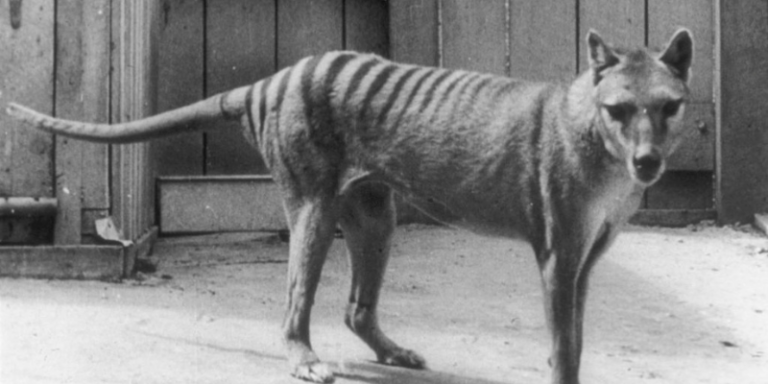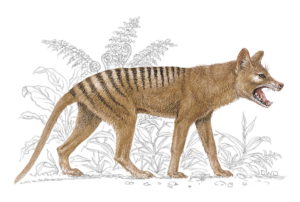Scientists Trying to Bring the Tasmanian Tiger Back from Extinction
It’s not Jurassic Park, but the idea of bringing back an extinct animal is similar.
By: Kelli Ballard | August 18, 2022 | 692 Words

Tasmanian Tiger (Photo by Dave WATTS/JACANA/Gamma-Rapho via Getty Images)
Scientists want to bring back the Tasmanian tiger, or thylacine, which has been extinct since 1936. While the name of the animal might make you think of a cross between a tiger and the Tasmanian Devil from the Looney Tunes cartoons, it is actually a marsupial, meaning it carries its young in a pouch like kangaroos.
De-Extinction of the Tasmanian Tiger
Not too different from the techniques used in the Jurassic Park movies, one science company is studying degraded genes from the thylacine to see if it can bring the species back to life.

(Photo by Gregor Fischer/picture alliance via Getty Images)
Colossal Biosciences thinks it can recreate the Tasmanian tiger with stem cells and gene-editing technology. The company suggests it could succeed within ten years by using CRISPR, a gene-editing tool. The researchers are also studying the DNA of one of the thylacine’s closest extant relatives, the fat-tailed dunnart, a mouse-sized marsupial.
Andrew Pask, an evolutionary biology professor at the University of Melbourne in Australia, has partnered with Colossal Biosciences. He said the idea is not just an experiment but is for the long term. “To bring a healthy population of thylacines back, you can’t bring back one or five,” he told CNET. “You’re looking at bringing back a good number of animals that you can put back into the environment.”
This isn’t a new idea. In 1999, the Australian Museum considered a project that would clone the Tasmanian tiger, and other attempts have been made to get DNA samples from the extinct animal.

Besides the thylacine, Colossal Biosciences wants to bring back the woolly mammoth by 2027. It plans to mix genes from the mammoth with those of the Asian elephant, which is the mammoth’s closest living relative. The creatures wouldn’t exactly be like the woolly mammoths of old, though. Ben Lamm, co-founder of Colossal, said it would be more like an “Arctic elephant,” with shaggy hair, curved tusks, small ears, and a domed forehead.
Is It Possible – or Ethical?
Not everyone thinks this is a good idea. While we’re not talking about the T-Rex from Jurassic Park, the idea can be a bit scary. Associate Professor Jeremy Austin from the Australian Centre for Ancient DNA doesn’t believe it’s really possible. He said, “De-extinction is a fairytale science” and that this project is “more about media attention for the scientists and less about doing serious science.”

(Photo by: Brown Bear/Windmill Books/Universal Images Group via Getty Images)
In the science community, de-extinction is controversial. It raises several concerns, such as what happens to the Tasmanian tiger if it is brought back and ends up becoming extinct again. What impact will reintroducing the creature into the wild have on the ecosystem, including plants, other animals, and people after nearly 100 years? Some scientists also worry that if the idea catches on and more species are brought back, there might not be enough resources to protect the animals we still have.
The Tasmanian Tiger
What was the Tasmanian tiger, and what happened to it?
The animal earned its nickname because of the stripes on its back, which made it look a bit like a tiger. In fact, it was a much smaller cross between a canine and a marsupial. The thylacine died out due to human hunting and competition from dingoes – a type of wild dog.

In the 1800s and early 1900s, European settlers in Tasmania blamed the thylacines for killing their sheep and chickens, and sought to get rid of them as pests. The species was hunted to near extinction. At the time, the Tasmanian tiger was the top predator in its area. Some researchers suggest that bringing it back could help to restore balance in the rainforests because it would hunt sick or weak animals, which might help to control the overpopulation of wallabies and kangaroos.
What do you think – is it possible to bring extinct species back to life? If so, is it something we should actually try?
















